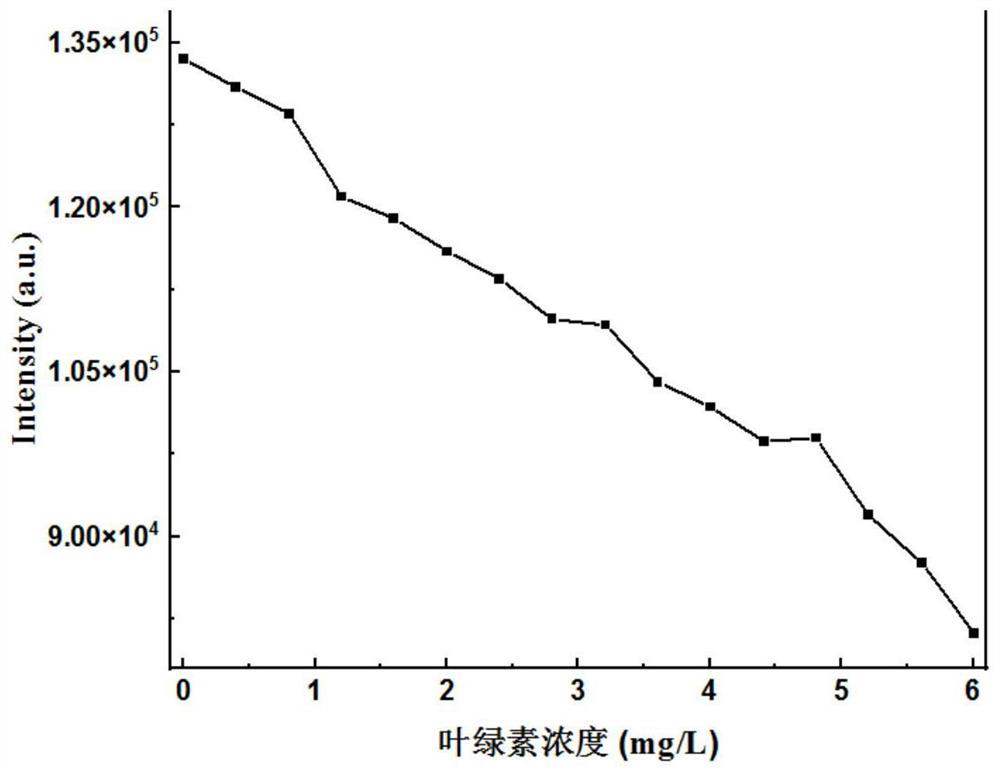Method for detecting microalgae content in ship ballast water
A technology for ship ballast water and detection methods, which is applied in the measurement of color/spectral characteristics, material excitation analysis, fluorescence/phosphorescence, etc., can solve the problems of low sensitivity, high price, long time, etc., and achieves good chemical and light stability. , Improve the detection sensitivity, reduce the effect of light damage
- Summary
- Abstract
- Description
- Claims
- Application Information
AI Technical Summary
Problems solved by technology
Method used
Image
Examples
Embodiment 1
[0030] Step 1): Take 2L of ballast water sample, filter and centrifuge to obtain 45.8mg of microalgae precipitate, add 1ml of dimethyl sulfoxide solvent to the microalgae precipitate for ultrasonic dispersion, then perform centrifugation and stand still, The obtained supernatant is chlorophyll solution A; measure the light absorption value of chlorophyll solution A at 649nm and 665nm, and calculate the content of chlorophyll a in microalgae solution A by the following formula;
[0031] C a =a×A 665 -b×A 649
[0032] In the formula, C a is the content of chlorophyll a, A 665 is the light absorption value of the solution at 665nm, A 649 is the absorbance value of the solution at 649nm, a is 12.47, b is 3.62,
[0033] The calculated content of chlorophyll a in the chlorophyll solution A is 20.22mg / L;
[0034] Step 2): 0.025mol NaYF 4 : Yb, Er up-conversion nano-fluorescence probe (average particle diameter is about 50nm) is added 0.5ml dimethyl sulfoxide solvent to disper...
Embodiment 2
[0043] Step 1): Take 1L of ballast water sample, filter and centrifuge to obtain 25.8mg of microalgae precipitate, add 2ml of acetone solvent to the microalgae precipitate for ultrasonic dispersion, and then perform centrifugation to obtain the supernatant which is chlorophyll Solution A; measure the light absorption value of chlorophyll solution A at 649nm and 665nm, and calculate the content of chlorophyll a in solution A by the following formula:
[0044] C a =a×A 665 -b×A 649
[0045] Here coefficient a=12.21, b=2.59, calculate the content of chlorophyll a in solution A to be 12.32mg / L;
[0046] Step 2): 0.25mol Y 2 o 2 S: Tm, Er up-conversion nano-fluorescence probe (average particle size is about 150nm) is dispersed by adding 0.5ml of acetone solvent, so that the concentration of up-conversion nano-fluorescence probe is 0.5mmol / L, forming probe solution B;
[0047] Step 3): Dilute the chlorophyll solution A to obtain chlorophyll solutions with different concentrati...
PUM
| Property | Measurement | Unit |
|---|---|---|
| size | aaaaa | aaaaa |
Abstract
Description
Claims
Application Information
 Login to View More
Login to View More - R&D
- Intellectual Property
- Life Sciences
- Materials
- Tech Scout
- Unparalleled Data Quality
- Higher Quality Content
- 60% Fewer Hallucinations
Browse by: Latest US Patents, China's latest patents, Technical Efficacy Thesaurus, Application Domain, Technology Topic, Popular Technical Reports.
© 2025 PatSnap. All rights reserved.Legal|Privacy policy|Modern Slavery Act Transparency Statement|Sitemap|About US| Contact US: help@patsnap.com



